Fuzheng Jiedu Decoction Induces Apoptosis and Enhances Cisplatin Efficacy in Ovarian Cancer Cells In Vitro and In Vivo through Inhibiting the PI3K/AKT/mTOR/NF- κ B Signaling Pathway
- PMID: 35281608
- PMCID: PMC8906977
- DOI: 10.1155/2022/5739909
Fuzheng Jiedu Decoction Induces Apoptosis and Enhances Cisplatin Efficacy in Ovarian Cancer Cells In Vitro and In Vivo through Inhibiting the PI3K/AKT/mTOR/NF- κ B Signaling Pathway
Abstract
Objectives: This study is aimed at investigating the anticancer activity of Fuzheng Jiedu decoction (FJD) alone or in combination with cisplatin in ovarian cancer (OC) models, as well as its underlying mechanisms of action.
Methods: The anticancer activities of FJD, cisplatin, and the combination of the PI3K inhibitor (LY294002, LY) or activator (IGF-1) were evaluated in OC cell lines in vitro and in a SKOV3 xenograft mouse model in vivo. The cell proliferation and invasion ability were measured using MTT, EdU, and transwell assays, respectively. The cell apoptosis was examined by flow cytometry and JC-1 assays. The expression levels of the Bcl-2 family and the PI3K/AKT/mTOR/NF-κB pathway-related proteins were analyzed by Western blot.
Results: The in vivo and in vitro studies showed that FJD administration could significantly inhibit cell proliferation and promote cell apoptosis in two OC cell lines SKOV3 and 3AO and partially decreased the tumor volumes and weights. In addition, FJD could significantly downregulate the protein levels of p-PI3K/PI3K, p-AKT/AKT, p-mTOR/mTOR, NF-κB, p38, and Bcl-2 and upregulate the Bax, Cyt-C, and cleaved caspase-3 in OC tumor tissues and cells. FJD cotreatment increased the efficacy of cisplatin, including inhibiting OC cell proliferation and invasion, promoting cell apoptosis, and inhibiting the PI3K/AKT/mTOR signaling pathway, while this enhancement was suppressed by IGF-1. Similarly, LY also enhanced the anticancer efficacy of cisplatin.
Conclusions: This study indicated that FJD could improve the efficacy of cisplatin by inhibiting the PI3K/AKT/mTOR/NF-κB signaling pathway. It is suggested that FJD may be a valuable adjuvant drug for the treatment of OC.
Copyright © 2022 Huadi Yang et al.
Conflict of interest statement
The authors declare that they have no conflicts of interest.
Figures



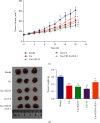
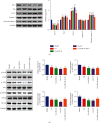
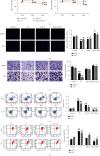
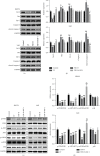

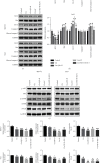
Similar articles
-
[Effects of PI3K/Akt/NF-κB signal pathway on FSH facilitation on cell proliferation and invasion by human epithelial ovarian cancer].Zhonghua Fu Chan Ke Za Zhi. 2012 Feb;47(2):134-8. Zhonghua Fu Chan Ke Za Zhi. 2012. PMID: 22455747 Chinese.
-
Sanguinarine inhibits epithelial ovarian cancer development via regulating long non-coding RNA CASC2-EIF4A3 axis and/or inhibiting NF-κB signaling or PI3K/AKT/mTOR pathway.Biomed Pharmacother. 2018 Jun;102:302-308. doi: 10.1016/j.biopha.2018.03.071. Epub 2018 Mar 22. Biomed Pharmacother. 2018. PMID: 29571014
-
Ginsenoside Rh2 impedes proliferation and migration and induces apoptosis by regulating NF-κB, MAPK, and PI3K/Akt/mTOR signaling pathways in osteosarcoma cells.J Biochem Mol Toxicol. 2020 Dec;34(12):e22597. doi: 10.1002/jbt.22597. Epub 2020 Aug 6. J Biochem Mol Toxicol. 2020. PMID: 32762018
-
Role of the PI3K/AKT/mTOR signaling pathway in ovarian cancer: Biological and therapeutic significance.Semin Cancer Biol. 2019 Dec;59:147-160. doi: 10.1016/j.semcancer.2019.05.012. Epub 2019 May 22. Semin Cancer Biol. 2019. PMID: 31128298 Review.
-
Myricetin-induced apoptosis in triple-negative breast cancer cells through inhibition of the PI3K/Akt/mTOR pathway.Med Oncol. 2022 Oct 8;39(12):248. doi: 10.1007/s12032-022-01856-z. Med Oncol. 2022. PMID: 36209343 Review.
Cited by
-
Processed Products of Aconitum soongaricum Stapf. Inhibit the Growth of Ovarian Cancer Cells In vivo via Regulating the PI3K/AKT Signal Pathway.Anticancer Agents Med Chem. 2025;25(9):630-642. doi: 10.2174/0118715206344374241219065154. Anticancer Agents Med Chem. 2025. PMID: 39844406
-
The FJQR Has Synergistic Effect with Fluoropyrimidine in the Maintenance Treatment for HER-2 Negative Gastric Cancer.Recent Pat Anticancer Drug Discov. 2024;19(2):165-175. doi: 10.2174/1574892818666230522161742. Recent Pat Anticancer Drug Discov. 2024. PMID: 38214356 Free PMC article.
-
In vitro analysis of the molecular mechanisms of ursolic acid against ovarian cancer.BMC Complement Med Ther. 2025 Feb 21;25(1):65. doi: 10.1186/s12906-025-04808-y. BMC Complement Med Ther. 2025. PMID: 39984915 Free PMC article.
-
Structure Elucidation of a Novel Polysaccharide Isolated from Euonymus fortunei and Establishing Its Antioxidant and Anticancer Properties.Int J Anal Chem. 2024 May 24;2024:8871600. doi: 10.1155/2024/8871600. eCollection 2024. Int J Anal Chem. 2024. PMID: 38827786 Free PMC article.
-
Jiedu Fuzheng decoction improves the proliferation, migration, invasion and EMT of non-small cell lung cancer via the Wnt/β-catenin pathway.Cell Div. 2023 Dec 16;18(1):22. doi: 10.1186/s13008-023-00105-7. Cell Div. 2023. PMID: 38104091 Free PMC article.
References
MeSH terms
Substances
LinkOut - more resources
Full Text Sources
Medical
Research Materials
Miscellaneous

